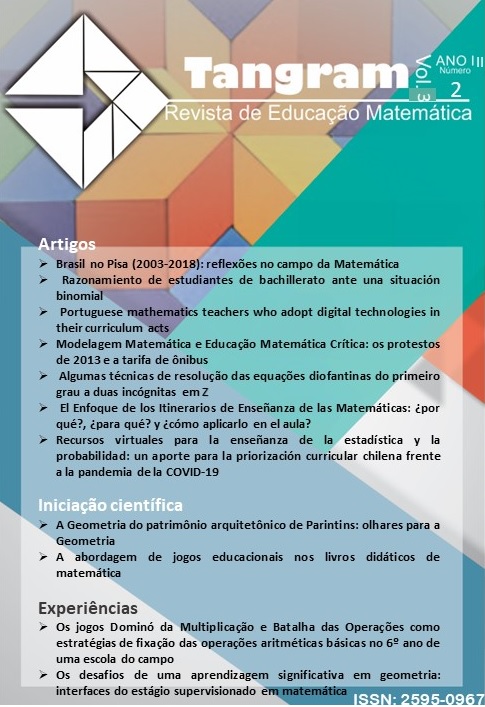The challenges of significant learning in geometry: interfaces of the supervised stage in mathematics
DOI:
https://doi.org/10.30612/tangram.v3i2.9296Keywords:
Education. Geometry. Experience report.Abstract
The development of skills and competences related to the aptitude for carrying out the pedagogical mediation process begins through the first contacts with the classroom. In this work we report the experiences lived during the period of Supervised Internship with students of elementary school II and high school, in the classes of Mathematics, in a school of the public state network, located in the city of Carangola, Minas Gerais. Geometry provides students with a type of thinking that allows them to assimilate and represent the world in an organized way, and for this reason it is extremely important. However, we verified through the observation of the classes that the way in which it was presented to the students, generated difficulties in understanding the contents. Therefore, and according to the analysis carried out in works by several authors such as Carvalho, Nascimento, Pavanello, among others, we believe that educational software is able to assist in the teaching and learning of this discipline.Downloads
References
Carvalho, R. L. de (2012). A criação de ambientes favoráveis à aprendizagem significativa crítica em contextos de cursos regulares nas aulas de matemática (Dissertação Mestrado). Universidade Federal de Ouro Preto, Ouro Preto, MG,Brasil.
Civiero, P. A. G., & Sant’ana, M. F. (2013). Roteiros de aprendizagem a partir da transposição didática reflexiva. Bolema: Boletim de Educação Matemática, 27 (46), 681-696. Recuperado de http://www.periodicos.rc.biblioteca.unesp.br/index.php/bolema/issue/view/95 3
Kakizaki, E. Y. (2000). Análise e reflexão para uma aprendizagem significativa no estudo da geometria.1-24.
Kampff, A. J. C., Machado, J. C., & Cavedini, P. (2004). Novas tecnologias e educação matemática. RENOTE, 2 (2), 1-11, Recuperado de https://seer.ufrgs.br/renote/article/view/13703
Leiva, J. C. P. (2012). Educação geométrica: reflexões sobre o ensino e aprendizagem em geometria. Educação Matemática em Revista–RS, 1(13), 9-16. Recuperado de http://sbem.iuri0094.hospedagemdesites.ws/revista/index.php/EMRRS/issue/view/107
Lovis, K. A., & Franco, V. S. (2013). Reflexões sobre o uso do GeoGebra e o Ensino de Geometria Euclidiana. Informática na educação: teoria & prática, 16 (1), 149- 160. Recuperado de https://seer.ufrgs.br/InfEducTeoriaPratica/article/view/26104/25946
Nascimento, E.G.A. (2012).Avaliação do software GeoGebra como instrumento psicopedagógico de ensino em geometria (Dissertação Mestrado). Universidade Federal do Ceará, Fortaleza, CE, Brasil.
Oliveira, C. de (2015). Tic’s na educação: A utilização das tecnologias da informação e comunicação na aprendizagem do aluno. Pedagogia em Ação, 7 (1), 75-95. Recuperado de http://periodicos.pucminas.br/index.php/pedagogiacao/article/view/11019
Pavanello, R. M. (1993). O abandono do ensino da geometria no Brasil: causas e consequências. Zetetiké, 1(1), 7-18. Recuperado de https://periodicos.sbu.unicamp.br/ojs/index.php/zetetike/issue/view/1235
Perius, A. A. B. (2012). A tecnologia aliada ao ensino de matemática (Especialização). Universidade Federal do Rio Grande do Sul, Cerro Largo, RS, Brasil.
Seegger, V., Canes, S. E., & Garcia, C. A. X. (2012). Estratégias tecnológicas na prática pedagógica. Revista Monografias Ambientais, 8 (8), 1887-1899, Recuperado de
https://periodicos.ufsm.br/remoa/article/view/6196/0
Universidade do Estado de Minas Gerais – UEMG.(2016). Projeto Pedagógico de Curso Licenciatura em Matemática [Projeto]. Composição Gestora da UEMG- unidade Carangola, Carangola, MG, Brasil.
Downloads
Published
How to Cite
Issue
Section
License
Authors must accept the publication rules when submitting the journal, as well as agree to the following terms:
(a) The Editorial Board reserves the right to make changes to the Portuguese language in the originals to maintain the cultured standard of the language, while respecting the style of the authors.
(b) Authors retain the copyright and grant the journal the right to first publication, with the work simultaneously licensed under the Attribution-NonCommercial-ShareAlike 3.0 Brazil (CC BY-NC-SA 3.0 BR) that allows: Share - copy and redistribute the material in any medium or format and Adapt - remix, transform, and create from the material. CC BY-NC-SA 3.0 BR considers the following terms:
- Attribution - You must give the appropriate credit, provide a link to the license and indicate whether changes have been made. You must do so under any reasonable circumstances, but in no way that would suggest that the licensor supports you or your use.
- NonCommercial - You may not use the material for commercial purposes.
- Sharing - If you remix, transform, or create from material, you must distribute your contributions under the same license as the original.
- No additional restrictions - You may not apply legal terms or technological measures that legally restrict others from doing anything that the license permits.
(c) After publication, authors are allowed and encouraged to publish and distribute their work online - in institutional repositories, personal page, social network or other scientific dissemination sites, as long as the publication is not for commercial purposes.






